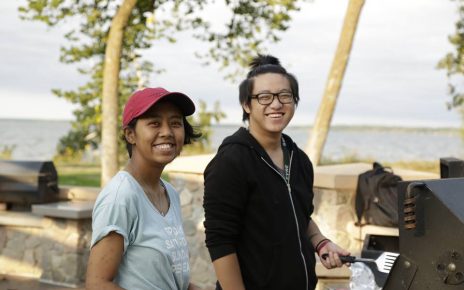by Zachary Malm
A unique story of an Anishinaabe warrior called Yellow Head is found among the annals of local lore and upon the lakes and shorelines that still bear his name. Referred to as a Berdache by the French or an agokwa in his own language, Yellow Head embodied the identity what can generally be explained as a third gender. In a society that divided labor by sex, Yellow Head, also called Ozaawindib, had purpose taking on roles of both genders, elevating his status in the community and often earning him a special role during religious ceremonies. Almost two full centuries ago, he passed through Lake Bemidji and secured a minor place in regional history.
The modern expression for these individuals within today’s Anishinaabe nation is “two-spirit,” which distinguishes from other contemporary LGBT terminology such as transgender or homosexual. The development of this concept was exclusive to New World cultures and rarely recorded by European explorers too prudish to repeat deeds of sexual deviancy. To have taken on a two-spirit wife would not have made the husband a homosexual, nor would Yellow Head have identified himself as a woman in a man’s body. Instead, a two-spirit possessed simultaneously characteristics of both genders, and as such was allowed to violate the traditional practices of gender-assigned labor. Women could hunt and even lead in the scalp-taking of a warparty, while two-spirit men remained home to tan hides, watch the children, and tap syrup from the trees during the cold stretches of winter.
Few written sources exist which mention Yellow Head. It is clear he belonged to the Pillager band of Ojibwe, an avant-garde group of warriors who pressed the western border of their country to compete with the Sioux nation for the rich hunting grounds of the headwaters of the Mississippi River. Fierce and warlike, the Pillagers had permanently occupied Leech Lake by the late eighteenth century and European merchants soon opened the region to the international fur trade. Stories circulated among the fur traders of Yellow Head’s speed and courage. Retreating from a camp of hostile Sioux, he had once secured all the arrows from his party and instructed the others to swiftly escape. Providing them time, he turned to face the pursuing enemy alone and let fly an enormous shower of arrows, dashing between trees and giving the impression of being many more warriors. Collecting the arrows that were shot at him, he maintained a steady resistance and easily evaded the Sioux beneath the shadows of the forest.
Earning his own place in history, Yellow Head is remembered primarily for guiding Henry Schoolcraft’s 1832 expedition to reach the Mississippi headwaters at Lake Itasca, a country which Yellow Head knew well and had hunted often.
Most of what is known about Yellow Head comes from John Tanner, a U.S. Interpreter operating out of Sault Ste. Marie during the first part of the nineteenth century. Taken captive as a child, John Tanner grew to adopt the customs of the Anishinaabe and was eventually called “The Falcon” among his people. Upon meeting Yellow Head, Tanner remarks in his narrative that there existed “several of this sort among most, if not all the Indian tribes; they are commonly called agokwa, a word which is expressive of their condition.”
Now fifty years old, Yellow Head was pursuing a marriage with The Falcon. Tanner recalls: “I do not know whether she had seen me, or only heard of me, but she soon let me know she had come a long distance to see me, and with hopes of living with me.” Undeterred by initial refusals, Yellow Head persisted with unwanted advancements and lucrative offers almost forcing John Tanner from the lodge, the matter unresolved until a neighboring chief accepted the offer instead. Already with two wives, this arrangement prompted only an occasional chuckle, and was met with less social resistance than a marriage with a female would have incurred. Incapable of birthing offspring and strong enough pull back a bow, a two-spirit wife made an undeniably powerful asset.
Yellow Head had taken many husbands. Though polygamy was common during this period, it was typically reserved for individuals of status and wealth that could provide safety against the fickle seasons. John Tanner’s own adopted mother had coerced multiple husbands to work in her lodges. Though not a two-spirit, Tanner’s mother challenged the gender barriers of her time and established herself as a prominent voice around council fires often dominated by male warriors and European traders. Powerful and able to provide, her gender alone did not merit consideration.
But centuries of pressure from Christian missionaries and accompanying capitalists eroded these historical values from the countryside. No longer able to celebrate the diversity found within their community, they were now governed by the values of their conquerors. Treaties signed at Prairie du Chien partitioned the indigenous populations onto manageable tracts of land. Sent to boarding schools, indigenous children were stripped of their inherited cultures and had foreign languages impressed upon their tongues. As their words were taken from them, so too were many of their historical ideas. One unintended participant in this supplantation was Yellow Head, expertly guiding Henry Schoolcraft to the deepest reaches of hard-won Pillager country and firing off muskets to salute the raising of the American flag.
As they passed through Bemidjigamaag, or Lake Bemidji, Yellow Head requested that the Schoolcraft Expedition make a short halt near the inlet of the Mississippi River to behold an object of Anishinaabe superstition that lay on the east shore. A tedious note taker, Schoolcraft’s journal remarked that he observed a sacred water-worn boulder, a large stone that had upon it a sort of image encircled by lines of paint. Nothing more is said about the object as they continued upstream several more days until reaching the headwaters, which was then called Omushkos, or Elk. The name was replaced and latinized into Lake Itasca. As for the boulder at Lake Bemidji, that too was replaced. After sitting empty for many years, a furniture store stands there today, surrounded by concrete and asphalt.



